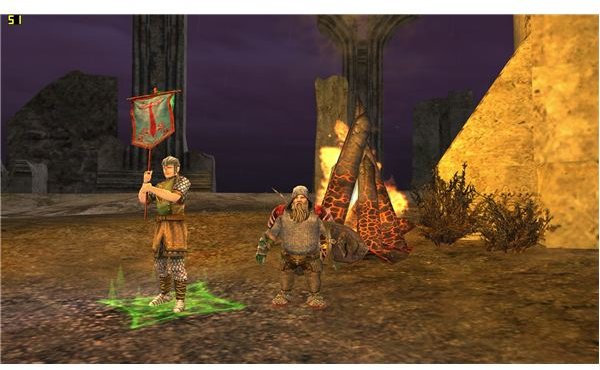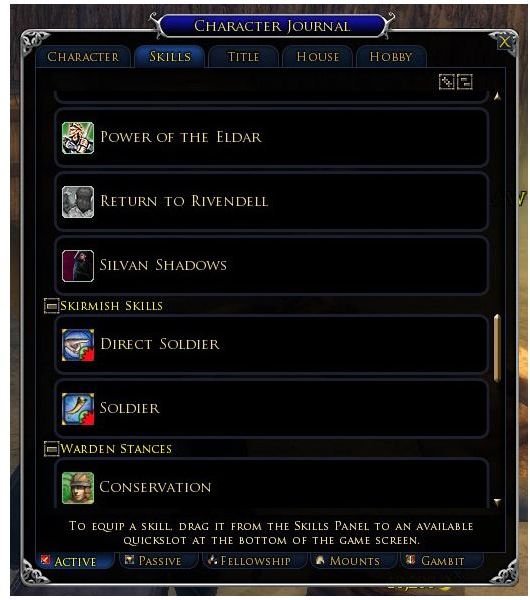LOTRO Skirmish Soldier Guide: Using Soldiers In Lord of the Rings Online Skirmishes

Soldier Basics
By now you should be familiar with what the skirmish system is and how to fight one. The in-game tutorial will have introduced you to the fundamentals of how soldiers work, but in case you need a quick refresh then here’s an overview of the basics.
Soldiers are NPCs that fight with you in skirmishes. They can be summoned inside skirmishes, but can’t be used in the rest of Middle Earth. If they’re defeated they can simply be summoned again, but only outside of combat. They’re mostly autonomous, although you have a limited ability to control them. You’ll have more of an impact on how your soldier fights before the actual skirmish starts, which is when you have the chance to pick your soldiers traits. This gives you control over everything from their appearance to their combat skills. They’re pretty easy to create and manage, but you have to make smart choices if you want your soldier to be effective. A few good decisions can make the difference between a well tuned fighting companion and a nuisance that’s constantly going down in defeat.
Picking a Role
There are six roles available for soldiers, and they all have unique skills and traits. You’ll want to pick the role that best compliments your own fighting style. Your soldier’s role can be changed at anytime, so don’t stress out too much about the decision, but also keep in mind that it can take a lot of work to build up a role until it’s strong enough to be effective so it can be time consuming to experiment too much.
The six roles are: archer, bannerguard, herbalist, protector, sage and warrior. Archers fight with bows to do large amounts of ranged damage. Bannerguards buff up allies and can do a little healing. Herbalists can’t fight but are expert healers. Protectors are defensive combatants that tank enemies. Sages weaken foe with debuffs and can do a reasonable amount of damage. Warriors focus on dishing out large amounts of melee damage.

The role you pick should be designed to enhance your own class. In some cases this gives you a few options. High DPS, low health hunters, for example, could pick a protector to soak up damage for them while they mow enemies down, or they could make their soldier into a herbalist to keep their health high while they try to take on most damage directly. Most combinations could work well to some degree, but generally speaking it’s most effective to choose a role that has skills in a category your own character’s class is weak in.
Selecting Traits
Traits are managed at skirmish camps, and there are four different types: attribute, training, skill and personal. Attribute traits control your soldier’s role, along with basic characteristics such as gender and hair colour. Training traits give your soldier passive bonuses. Skills give your soldier the ability to actively use different skills in combat, and finally personal traits are passive bonuses to your own character that apply only during skirmishes.

Other than picking the proper role as discussed above, attributes mostly come down to personal taste. There are no bonuses or penalties for physical characteristics, and unlike with player characters any race can be any role. Training, skill and personal traits are varied and numerous; to list all the possible combinations would go well beyond the scope of this guide. However, it shouldn’t be too hard to select the proper ones; many training traits only work for certain roles, and for personal skills it should be fairly obvious which ones your class can take advantage of. Skills are also role specific, so again, no matter which ones you pick your soldier should be able to benefit from them somehow.
What’s most important to keep in mind is that the vast majority of traits have ranks, from one to twenty. It’s better to spend your skirmish marks on a few high rank traits rather than spreading out a bunch of weaker ones. Most important is to level up the role attribute itself, which increases your soldier’s morale, power and a third stat relevant to the role. Getting this rank up will often make the difference between an effective soldier and one that gets defeated constantly; this is especially true when you’re fighting high level skirmishes. So don’t be too surprised if your soldier dies often in your first few skirmishes. Just keep ranking up his skills and he’ll be much tougher in no time.
Using your Soldier in Battle
Unlike a loremaster’s pet or a captain’s follower, soldiers can’t really be controlled directly. Players do have the ability to order their soldiers to attack a specific target, but beyond that they’re free to do as they see fit. You’ll have no way to control what skills they use and when, so the best way to make your soldier effective in combat is to trait him well before the battle, rather than hoping to control him during a fight.

However, that doesn’t mean you should simply ignore your soldier in a skirmish. The ability to direct your soldier’s attack can be quite valuable, especially if there’s a powerful enemy that you either need to kill quickly or need to have its damage soaked up by a defensive role. However, the most effective way to make use of your soldier is to keep an eye on what he’s doing and attempt to work together with him. If your soldier is an archer, for example, you should try to target the same enemy that he’s attacking in order to maximise damage, while at the same time attempting to keep enemies from swarming him due to his weak armour. Conversely, if your soldier is a protector, you should let him draw the attention of enemies and take advantage of the fact that you’re being ignored, without taking aggro away from your comrade.
Using your soldier well in skirmishes usually just comes down to common sense. If you equip your soldier with the right traits and treat him like any other ally in combat, then he should prove to be an effective fighting companion that makes skirmishes easier.
References
- Information gained from author experience
- Images are from Lord of the Rings Online
This post is part of the series: A Guide to Lord of the Rings Online’s Skirmish System
LOTRO’s new Skirmish system is big, and the way it’s played is very different from the rest of the game. This guide will give you a quick overview of the system before showing you the details of its most important aspects.
